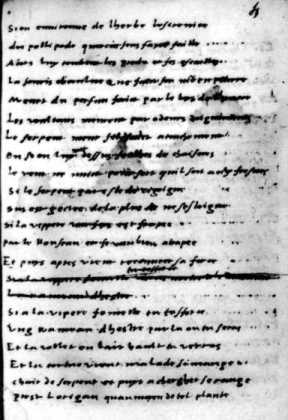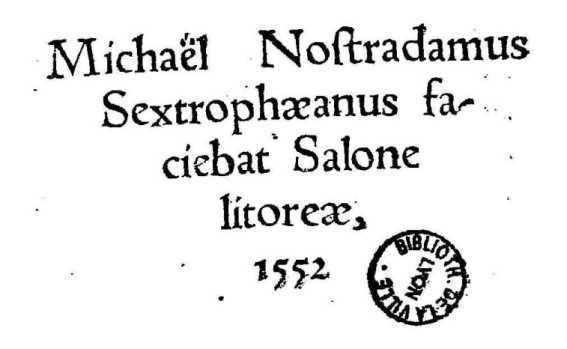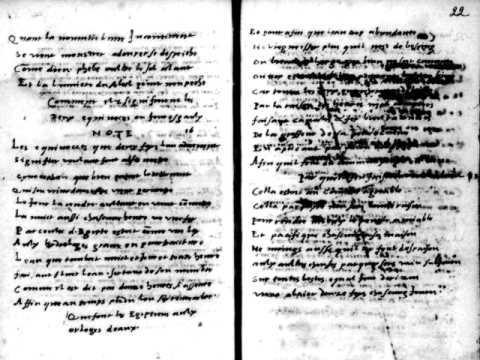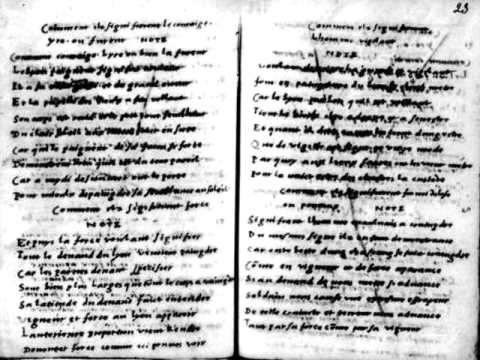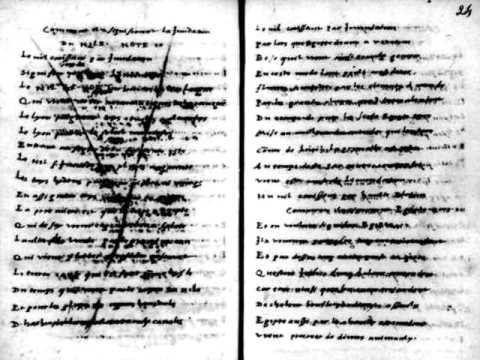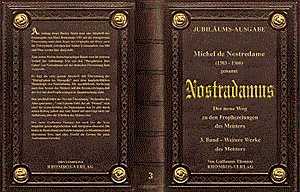
I hope that you have some time to look around here.
© by Wilhelm Zannoth

Nostradamus - originals
Prognosticon 1560 (German)
Pronostication nouvelle 1562
Propheties 1568 Lyon
Bibliography
Guillaume Thonnaz
my 3 Nostradamus - books
Reviews on my books
Propheties - comparisons
Short analysis to the editions
Orus Apollo
Orus Apollo - comparison
The Orus Apollo - manuscript
Leoninic verses
Scaliger & Nostradamus
Index & poulse
The Nostradamus grave plate
Genealogy
Pages under construction !
Maldoner - Malthaner
Zannoth & Fritz
Web - Links
Impressum
The Orus Apollo - manuscript
and some peculiarities of it.
To the comparison I inserted the "uncleaned" (the original) and the "cleaned" title page here.
to increase the pictures of this side please click on them and then back !
Since there is only very a few handwritings from Nostradamus,
naturally also his signatures are rare and as one here can see , some kind of strange!
Robert Benazra shows the 1. Signature on his HP as comparison to the copied signature of the "Michel de Nostradamus, le jeune",
how a more smartly author called himself after the death of the master and prints and sales falsified yearbooks.

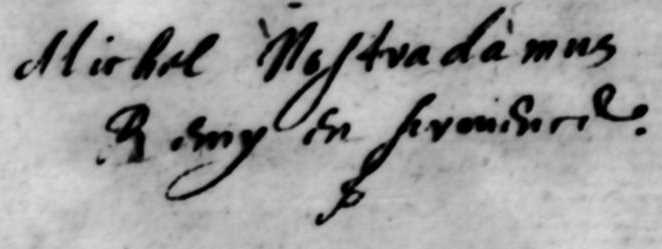
here the above signature of the Horapollo with the special characteristic down at "Province" !
In my 3. Book - "further works of the master" I copied and translated into the German language the text of this manuscript (nearly) completely.
I referred to the difficulties which I had, to read already there the text of the bad copy of the film. Today I know that also my copy contains still some errors, but with the small interest that exists in this text, is it for me uninteresting to publish a new version .
That this is the first Text which we have from Nostradamus, is well-known and the age of the paper became by an analysis on the time between 1535 and 1539 fixed.
The text is dedicated to the princess of Navarra Jeanne d'Albret (1528 - 1572) and after she became married with 13 years on 14 June 1541 the first time, the manuscript is written also in this year or in former times. This marriage became divorced in 1545.
A further cause could have been her second wedding with Antoine de Bourbon on 20 October 1548, then the manuscript in each case is written before 1548 !
For the emergence of the dedication her wedding would have been naturaly a cause, but then there would have to be still another "recopy" or a print, because the master will hardly have presented this not very decorative manuscript to the princess.
The originally Greek text was first printed 1505 and then in two languages (Greec and French) transfered from Bernardino Trebatio 1521.
The manuscript of Nostradamus contains now however as the first, some changes in relation to the earlier originals !
It brings more text - after an old writing of the Druides - and he writes partly very detailed explanations with the individual paragraphs.
Also the arrangement of the texts - in the rhythm of epigrammes - was not before used and also not afterwards. Whether the anonymous "Kerver expenditure of 1543" is now from Nostradamus or not, it contains in any case also a part of the additional texts that Nostradamus first used. Since it is dated now, as can be proved, later than the manuscript, the possibility quite exists that the anonymous author copied from the master !
The manuscript is an in any case remarkable and interesting document over the handwriting and a "draft" from Nostradamus !
Already with the title page it is noticeable that he writes: "in the rhythm of epigrammes" and not in "rhymes" or "verses" !
He has this "rhythm" in the preface to king Henri - "la rithme estre autant facile," (p.5) and in the Centurie 10 verse 8 "index & poulse parfondera le front" as "pulse" mentioned !
Very interesting is also his use of different character fonts and the conscious large and lower case of individual letters. One can evaluate that as a clear reference to the application of the "Steganography", that straight at his time an renaissance experienced by the books and writings of Trithemius, Agrippa etc.!
It continues to be remarkable that he here very often uses the large letter "J", which he did not use in his Centuries. He partly uses it even as "I", but he uses also the normal "i" several times!
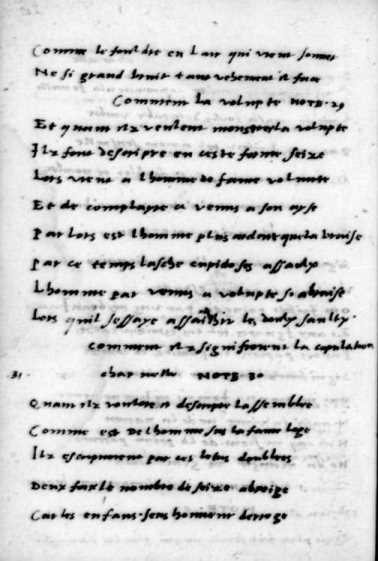
page 26v
In the 5. line from above "Jlz" with "J" and in the 4. line from down "Ilz" with "I" written !
On page 40v, at the end of the first part, the master forgot even a letter of his own name and he writes "NOSTRADMVS" !
Here we find also the note that he copied the additions after an old copy of the Druides !
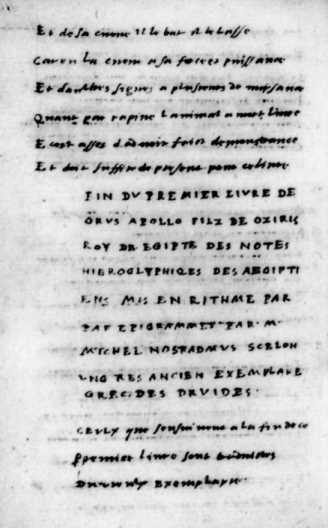
page 40v
Spelling mistake or intention - that is here the large question ?
After I had carried the "rough" preliminary work out, and made available the entire text copied as computer file, Patrice Guinard made himself the trouble to regard the manuscript again more exactly and to write a detailed article over it. He noted some errors of the "Rollet-edition", also he numbered the individual pages, all lines and partly even the letters of the epigrammes. The "number data" he needed - for his number code derived from the last will of the master - he apparent found thereby and explained also in detail.
Unfortunately he not correctly considered the large and lower case letters, to which I referred in my books specially !
(how should he, he did not read my German
books !)
If we regard the original exactly, then we would have to write all the words with "J" also, which actually here are beginning with large "J", what I did not make however also !
That he used the apostrophes (l'estomach), I still can understand, but he would have had to consider the capitalization , even if he wrote to me: "that was in former times so generally usual" !
| Que vouloient ilz signifier par le Doigt Et en voulant bien l'estomach cognoistre Que venoient ilz pour cella indiquer Le doigt de l'homme nous faisoient aparoistre Car le doigt vient l'estomach indiquer Le doigt indicque que l'ont vient apliquer De l'estomach fainct juste de monstrance Qu'estoit besoing le signe repliquer Du ventricule la vraye intelligence |
Que vouloient ilz signifier par le Doigt
NOTE 72 Et en voulant bien lestomach cognoistre Que venoient ilz pour cella Indiquer Le doigt de l homme nous faisoient aparoistre Car le doigt vient lestomach Indiquer Le doigt Indique que lont vient apliquer De lestomach fainct Iuste de monstrance Questoit besoing le signe Repliquer Du ventricule la vraye Intelligence |
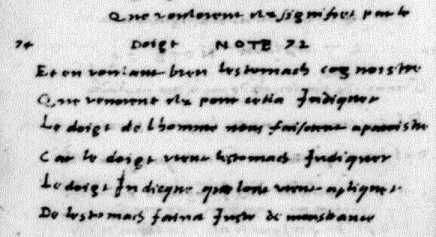
Patrice has the first empty sheet not taken in account and so does not agree his numbering with the numbers of the original pictures - sides.
It's "generally" usual to mark the sheets and not the sides, but whether it is expedient, is another question.
As already described in my book, apparent the photographer put the numbers on the pages. The numbers go from 1 on the title page up to 86 on the next to last empty sheet. Since the photographer has always 2 sides on a picture, in each case only the right side carries a number.
With Patrice is now the 1. side on the right the No. 1r (recto) and the back, those actually (picture -) No. 2 left is, carries the No. 1v (verso) = 1. Back !
Something complicated, because 1 left and 1 right, would be better to understand and became to agree with the original (picture -) sides - numbers !
Also Patrice was not apparent noticeable that Nostradamus marked individual sides down with letters. It looks in such a way, as if this would be a marking for the later print bow. The letters go from large "A" up to the large "O", whereby partly each 4. double - side drawn is, but partly also only each 8. double - side. Also additionally the same letters are partly in small writing with the number of "1" attached.
So it looks alike, that by the time Nostradamus wrote this manuscript, he had already made his experiences with the printers and attached therefore the markings for the typesetter, how the individual bows and sides are attached !
The letters are on the following pages:
Frontpage = + (cross), "A" = p. 9r, "B b1" = p. 13r, "C c1" = p. 17r, "D d1" = p. 21r, "E" = p. 25r, "F" = p. 33r, "G" = p. 41r, "H" = p. 49r, "I" = p. 53r, "K" = p. 57r, "L" = p. 65r, "M" = p. 69r, "N" = p. 77r, "O" = p. 82r !
Since we have no data concerning the print of a work of him before 1550 (first yearbook), does the question arise why he attached the markings ?
The first, still existing prints, are the 2 different "Propheties" - editions of 1555 and then the recipe book of 1556 "Excellent & moult ...", which is dated however in the last part on page 226 with 1552 !
So we can assume that this book was already printed 1552 the first time, but this edition is misssing today !
This work was again and again printed in the following years and was apparent already thereby a "best seller".
Patrice continues to write with side 22r "crossed out, but why ?".
As we see also with side 23v, Nostradamus corrected and overwrited here too much. He through-crossed this side then as "illegibly" !
The cross of the side 22r appears weakly also on the back-page 22v and it has a different angle than the one on the next side !
With p. 23v one can recognize that clearly, and on p. 24r Nos. again arranged the text of the "Nile" , but without the heading "Comment ilz...". Also one sees clear that with the wet ink of the cross-out the "cross" on the back (23r) again appears !
The diagonal lines are in any case in the same angle, even if naturally mirror-operated.
After he described the page 24r, apparent that the master let the manuscript open to dry. Since on this side the cross is not to be seen no more, he does not have turned the page to continue to write !
Still at the text of the Horapollo 2 clear referrings to the text of the prophecies are remarkable !
First on page 11 left - "FELICI ARABIAE REPERTUM", where a connection can be made with the verse of the Centurie V. 55 - "De la felice Arabie contrade".
Then on page 84 right - "Comment il(z) appelloient les dieux Infernaulx qu'ilz appelloient manes. D. M.". Here we find the connection with Centurie 8 verse 66 "Quand l'escriture D. M. trouuee,"!
The moreover it noticed to me that a connection to the "Sixains" can exist here also, since here and there the "elephant" and the "crocodile" are several times called in each case !
Also in the criticism of L. Videl a "elephant" emerges !
In the "Sixains" connections to the "Propheties" can be proven again perfectly, as we can see at "index & poulse" !
Those are many inconsistencies and there many
questions remain still open !
There is still much to do, lets get started !
There is still much to do, lets get started !
© Guillaume Thonnaz 2005
